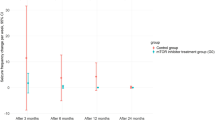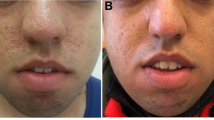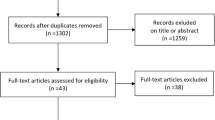Abstract
Tuberous sclerosis complex (TSC) is a genetic disorder arising from mutations in the TSC1 or TSC2 genes. The resulting over-activation of the mammalian target of rapamycin (mTOR) signalling pathway leaves patients with TSC susceptible to the growth of non-malignant tumours in multiple organs. Previously, surgery was the main therapeutic option for TSC. However, pharmacological therapy with mTOR inhibitors such as everolimus and sirolimus is now emerging as an alternate approach. Everolimus and sirolimus have already been shown to be effective in treating subependymal giant cell astrocytoma (SEGA) and renal angiomyolipoma (AML), and everolimus is currently being evaluated in treating TSC-related epilepsy. In November 2013 a group of European experts convened to discuss the current options and practical considerations for treating various manifestations of TSC. This article provides evidence-based recommendations for the treatment of SEGA, TSC-related epilepsy and renal AML, with a focus on where mTOR inhibitor therapy may be considered alongside other treatment options. Safety considerations regarding mTOR inhibitor therapy are also reviewed. With evidence of beneficial effects in neurological and non-neurological TSC manifestations, mTOR inhibitors may represent a systemic treatment for TSC.



Similar content being viewed by others
References
Nellist M, van den Heuvel D, Schluep D, Exalto C, Goedbloed M, Maat-Kievit A, et al. Missense mutations to the TSC1 gene cause tuberous sclerosis complex. Eur J Hum Genet. 2009;17(3):319–28.
Curatolo P, Moavero R. mTOR inhibitors in tuberous sclerosis complex. Curr Neuropharmacol. 2012;10(4):404–15.
Curatolo P, Bombardieri R, Jozwiak S. Tuberous sclerosis. Lancet. 2008;372(9639):657–68.
Moavero R, Coniglio A, Garaci F, Curatolo P. Is mTOR inhibition a systemic treatment for tuberous sclerosis? Ital J Pediatr. 2013;39:57.
Northrup H, Krueger DA, International Tuberous Sclerosis Complex Consensus Group. Tuberous sclerosis complex diagnostic criteria update: recommendations of the 2012 international tuberous sclerosis complex consensus conference. Pediatr Neurol. 2013;49:243–54.
Krueger DA, Northrup H, International Tuberous Sclerosis Complex Consensus Group. Tuberous sclerosis complex surveillance and management: recommendations of the 2012 international tuberous sclerosis complex consensus conference. Pediatr Neurol. 2013;49(4):255–65.
Curatolo P, Moavero R, de Vries PJ. Neurological and neuropsychiatric aspects of tuberous sclerosis complex. Lancet Neurol. 2015;14(7):733–45.
Curran MP. Everolimus: in patients with subependymal giant cell astrocytoma associated with tuberous sclerosis complex. Paediatric Drugs. 2012;14:51–60.
Franz DN. Everolimus: an mTOR inhibitor for the treatment of tuberous sclerosis. Expert Rev Anticancer Ther. 2011;11:1181–92.
Krueger DA, Care MM, Holland K, Agricola K, Tudor C, Mangeshkar P, et al. Everolimus for subependymal giant-cell astrocytomas in tuberous sclerosis. N Engl J Med. 2010;363(19):1801–11.
Bissler JJ, Kingswood JC, Radzikowska E, Zonnenberg BA, Frost M, Belousova E, et al. Everolimus for angiomyolipoma associated with tuberous sclerosis complex or sporadic lymphangioleiomyomatosis (EXIST-2): a multicentre, randomised, double-blind, placebo-controlled trial. Lancet. 2013;381(9869):817–24.
Franz DN, Belousova E, Sparagana S, Bebin EM, Frost M, Kuperman R, et al. Efficacy and safety of everolimus for subependymal giant cell astrocytomas associated with tuberous sclerosis complex (EXIST-1): a multicentre, randomised, placebo-controlled phase 3 trial. Lancet. 2013;381(9861):125–32.
Krueger DA, Wilfong AA, Holland-Bouley K, Anderson AE, Agricola K, Tudor C, et al. Everolimus treatment of refractory epilepsy in tuberous sclerosis complex. Ann Neurol. 2013;74(5):679–87.
Franz DN, Agricola K, Mays M, Tudor C, Care MM, Holland-Bouley K, et al. Everolimus for subependymal giant cell astrocytoma: 5-year final analysis. Ann Neurol. 2015;78:929–38. doi:10.1002/ana.24523.
Jóźwiak S, Nabbout R, Curatolo P, participants of the TSC Consensus Meeting for SEGA and Epilepsy Management. Management of subependymal giant cell astrocytoma (SEGA) associated with tuberous sclerosis complex (TSC): clinical recommendations. Eur J Paediatr Neurol. 2013;17(4):348–52.
Amin S, Carter M, Edwards RJ, Pople I, Aquilina K, Merrifield J, et al. The outcome of surgical management of subependymal giant cell astrocytoma in tuberous sclerosis complex. Eur J Paediatr Neurol. 2013;17(1):36–44.
Roth J, Roach ES, Bartels U, Jóźwiak S, Koenig MK, Weiner HL, et al. Subependymal giant cell astrocytoma: diagnosis, screening, and treatment. Recommendations from the international tuberous sclerosis complex consensus conference 2012. Pediatr Neurol. 2013;49(6):439–44.
Perek-Polnik M, Jóźwiak S, Jurkiewicz E, Perek D, Kotulska K. Effective everolimus treatment of inoperable, life-threatening subependymal giant cell astrocytoma and intractable epilepsy in a patient with tuberous sclerosis complex. Eur J Paediatr Neurol. 2012;16(1):83–5.
Afinitor® (everolimus). Prescribing information. Novartis, revised July 2014. http://www.pharma.us.novartis.com/product/pi/pdf/afinitor.pdf. Accessed 1 Sept 2014.
Kotulska K, Borkowska J, Roszkowski M, Mandera M, Daszkiewicz P, Drabik K, et al. Surgical treatment of subependymal giant cell astrocytoma in tuberous sclerosis complex patients. Pediatr Neurol. 2014;50(4):307–12.
Krueger DA, Care MM, Agricola K, Tudor C, Mays M, Franz DN. Everolimus long-term safety and efficacy in subependymal giant cell astrocytoma. Neurology. 2013;80(6):574–80.
ClinicalTrials.gov identifier: NCT01713946. A placebo-controlled study of efficacy and safety of 2 trough-ranges of everolimus as adjunctive therapy in patients with tuberous sclerosis complex (TSC) and refractory partial-onset seizures (EXIST-3). Accessed 1 Sept 2014.
Davies DM, de Vries PJ, Johnson SR, McCartney DL, Cox JA, Serra AL, et al. Sirolimus therapy for angiomyolipoma in tuberous sclerosis and sporadic lymphangioleiomyomatosis: a phase 2 trial. Clin Cancer Res. 2011;17(12):4071–81.
Bissler JJ, McCormack FX, Young LR, Elwing JM, Chuck G, Leonard JM, et al. Sirolimus for angiomyolipoma in tuberous sclerosis complex or lymphangioleiomyomatosis. N Engl J Med. 2008;358(2):140–51.
Dabora SL, Franz DN, Ashwal S, Sagalowsky A, DiMario FJ Jr, Miles D, et al. Multicenter phase 2 trial of sirolimus for tuberous sclerosis: kidney angiomyolipomas and other tumors regress and VEGF-D levels decrease. PLoS One. 2011;6(9):e23379.
Franz DN, Belousova E, Sparagana S, Bebin EM, Frost M, Kuperman R, et al. Everolimus for supependymal giant cell astrocytoma in patients with tuberous sclerosis complex: 2-year open-label extension of the randomised EXIST-1 study. Lancet Oncol. 2014;15(13):1513–20.
Moavero R, Pinci M, Bombardieri R, Curatolo P. The management of subependymal giant cell tumors in tuberous sclerosis: a clinician’s perspective. Childs Nerv Syst. 2011;27(8):1203–10.
Torres VE, King BF, McKusick MA, Bjornsson J, Zincke H. Update on tuberous sclerosis complex. Contrib Nephrol. 2001;136:33–49.
Cusmai R, Moavero R, Bombardieri R, Vigevano F, Curatolo P. Long-term neurological outcome in children with early-onset epilepsy associated with tuberous sclerosis. Epilepsy Behav. 2011;22(4):735–9.
Jóźwiak S, Kotulska K, Domańska-Pakieła D, Lojszczyk B, Syczewska M, Chmielewski D, et al. Antiepileptic treatment before the onset of seizures reduces epilepsy severity and risk of mental retardation in infants with tuberous sclerosis complex. Eur J Paediatr Neurol. 2011;15(5):424–31.
Domańska-Pakieła D, Kaczorowska M, Jurkiewicz E, Kotulska K, Dunin-Wąsowicz D, Jóźwiak S. EEG abnormalities preceding the epilepsy onset in tuberous sclerosis complex patients—a prospective study of 5 patients. Eur J Paediatr Neurol. 2014;18(4):458–68.
Curatolo P, Jóźwiak S, Nabbout R, TSC Consensus Meeting for SEGA and Epilepsy Management. Management of epilepsy associated with tuberous sclerosis complex (TSC): clinical recommendations. Eur J Paediatr Neurol. 2012;16(6):582–6.
Bombardieri R, Pinci M, Moavero R, Cerminara C, Curatolo P. Early control of seizures improves long-term outcome in children with tuberous sclerosis complex. Eur J Paediatr Neurol. 2010;14(2):146–9.
Zhang B, McDaniel SS, Rensing NR, Wong M. Vigabatrin inhibits seizures and mTOR pathway activation in a mouse model of tuberous sclerosis complex. PLoS One. 2013;8:e57445.
Willmore LJ, Abelson MB, Ben-Menachem E, Pellock JM, Shields WD. Vigabatrin: 2008 update. Epilepsia. 2009;50(2):163–73.
Hancock EC, Osborne JP, Edwards SW. Treatment of infantile spasms. Cochrane Database Syst Rev. 2013;6:CD001770.
Zhang K, Hu WH, Zhang C, Meng FG, Chen N, Zhang JG. Predictors of seizure freedom after surgical management of tuberous sclerosis complex: a systematic review and meta-analysis. Epilepsy Res. 2013;105(3):377–83.
Pittau F, Grouiller F, Spinelli L, Seeck M, Michel CM, Vulliemoz S. The role of functional neuroimaging in pre-surgical epilepsy evaluation. Front Neurol. 2014;5:31.
Kotulska K, Chmielewski D, Borkowska J, Jurkiewicz E, Kuczyński D, Kmieć T, et al. Long-term effect of everolimus on epilepsy and growth in children under 3 years of age treated for subependymal giant cell astrocytoma associated with tuberous sclerosis complex. Eur J Paediatr Neurol. 2013;17(5):479–85.
Zamponi N, Petrelli C, Passamonti C, Moavero R, Curatolo P. Vagus nerve stimulation for refractory epilepsy in tuberous sclerosis. Pediatr Neurol. 2010;43(1):29–34.
Kossoff EH, Thiele EA, Pfeifer HH, McGrogan JR, Freeman JM. Tuberous sclerosis complex and the ketogenic diet. Epilepsia. 2005;46(10):1684–6.
Larson AM, Pfeifer HH, Thiele EA. Low glycemic index treatment for epilepsy in tuberous sclerosis complex. Epilepsy Res. 2012;99(1–2):180–2.
Elliott RE, Carlson C, Kalhorn SP, Moshel YA, Weiner HL, Devinsky O, et al. Refractory epilepsy in tuberous sclerosis: vagus nerve stimulation with or without subsequent resective surgery. Epilepsy Behav. 2009;16(3):454–60.
McDaniel SS, Rensing NR, Thio LL, Yamada KA, Wong M. The ketogenic diet inhibits the mammalian target of rapamycin (mTOR) pathway. Epilepsia. 2011;52:e7–11.
Northrup H, Krueger DA, International Tuberous Sclerosis Complex Consensus Group. Tuberous sclerosis complex diagnostic criteria update: recommendations of the 2012 international tuberous sclerosis complex consensus conference. Pediatr Neurol. 2013;49(4):243–54.
Dixon BP, Hulbert JC, Bissler JJ. Tuberous sclerosis complex renal disease. Nephron Exp Nephrol. 2011;118(1):e15–20.
Kingswood JC, Demuth D, Nasuti P, Lucchese L, Gray E, Magestro M. Real-world assessment of renal involvement in tuberous sclerosis complex (TSC) patients in the United Kingdom (UK) [abstract 318]. Eur Urol Suppl. 2014;13(1):e318–a.
Kingswood JC, Jozwiak S, Belousova ED, Frost MD, Kuperman RA, Bebin EM, et al. The effect of everolimus on renal angiomyolipoma in patients with tuberous sclerosis complex being treated for subependymal giant cell astrocytoma: subgroup results from the randomized, placebo-controlled, Phase 3 trial EXIST-1. Nephrol Dial Transplant. 2014;29(6):1203–10.
Bissler JJ, Kingswood JC, Radzikowska E, Zonnenberg BA, Frost M, Belousova E, et al. Everoliums for renal angiomyolipoma in patients with tuberous sclerosis complex or sporadic lymphangioleiomyomatosis: extension of a randomized controlled trial. Nephrol Dial Transplant. 2016;31(1):111–9.
Kaplan B, Qazi Y, Wellen JR. Strategies for the management of adverse events associated with mTOR inhibitors. Transplant Rev (Orlando). 2014;28(3):126–33.
Rugo HS, Pritchard KI, Gnant M, Noguchi S, Piccart M, Hortobagyi G, et al. Incidence and time course of everolimus-related adverse events in postmenopausal women with hormone receptor-positive advanced breast cancer: insights from BOLERO-2. Ann Oncol. 2014;25(4):808–15.
Bissler JJ, Kingswood JC, Zonnenberg BA, Frost M, Belousova E, Sauter M, et al. Effect of everolimus on renal function in patients with tuberous sclerosis complex (TSC): results from EXIST-1 and EXIST-2 [abstract TO006]. Presented at the 51st ERA-EDTA Congress, 31 May to 3 June 2014, Amsterdam, The Netherlands.
Adhikari D, Zheng W, Shen Y, Gorre N, Hämäläinen T, Cooney AJ, et al. Tsc/mTORC1 signaling in oocytes governs the quiescence and activation of primordial follicles. Hum Mol Genet. 2010;19(3):397–410.
Braun M, Young J, Reiner CS, Poster D, Krauer F, Kistler AD, et al. Low-dose oral sirolimus and the risk of menstrual-cycle disturbances and ovarian cysts: analysis of the randomized controlled SUISSE ADPKD trial. PLoS One. 2012;7(10):e45868.
Struijk GH, Minnee RC, Koch SD, Zwinderman AH, van Donselaar-van der Pant KA, Idu MM, et al. Maintenance immunosuppressive therapy with everolimus preserves humoral immune responses. Kidney Int. 2010;78(9):934–40.
ClinicalTrials.gov identifier: NCT01954693. A study of everolimus in the treatment of neurocognitive problems in tuberous sclerosis (TRON). Accessed 1 Sept 2014.
ClinicalTrials.gov identifier: NCT01730209. Efficacy of RAD001/everolimus in autism and neuropsychological deficits in children with tuberous sclerosis complex (RAPIT). Accessed 1 Sept 2014.
ClinicalTrials.gov identifier: NCT01929642. Rapalogues for autism phenotype in TSC: a feasibility study (RAPT). Accessed 26 Jan 2016.
ClinicalTrials.gov identifier: NCT02634931. Long-term trial of topical sirolimus to angiofibroma in patient with tuberous sclerosis complex. Accessed 26 Jan 2016.
ClinicalTrials.gov identifier: NCT02635789. Phase III trial of topical formulation of sirolimus to skin lesions in patients with tuberous sclerosis complex (TSC). Accessed 26 Jan 2016.
Kingswood JC, Bruzzi P, Curatolo P, de Vries PJ, Fladrowski C, Hertzberg C, et al. TOSCA—first international registry to address knowledge gaps in the natural history and management of tuberous sclerosis complex. Orphanet J Rare Dis. 2014;26(9):182. doi:10.1186/s13023-014-0182-9.
Acknowledgments
The authors wish to acknowledge the expert contribution from Dr. De Wit (Erasmus MC, Rotterdam, The Netherlands) attending the VEnice Network In Clinical Excellence Masterclass meeting.
Author information
Authors and Affiliations
Corresponding author
Ethics declarations
Funding
The VEnice Network in Clinical Excellence Masterclass meeting organized and supported by Novartis, formed the basis for this publication. The authors are fully responsible for the content of this manuscript. Medical writing support used for this article in terms of final editing and formatting of the draft manuscript was provided by Excerpta Medica, funded by Novartis, and none of the authors received any funding for the preparation of this manuscript. The work of PC, AJ, KK, SJ, RN, MF, CH, RM was partially supported by the Seventh Framework Programme of European Commission within the Large-scale Integrating Project EPISTOP (Proposal No: 602391-2).
Conflict of interest
PC was on the study steering committee of EXIST-1 and 3 trials funded by Novartis. He is also on the Scientific Advisory Board of TOSCA, a natural history study of tuberous sclerosis, funded by Novartis, and has received honoraria from Novartis for participation in advisory board meetings. MB is the national coordinator (Norway) of the EXIST-1 trial and TOSCA (international disease registry of tuberous sclerosis), funded by Novartis. PED has received consulting fees from Novartis. JCF has received honoraria and support from Novartis for travel to the VENICE (VEnice Network In Clinical Excellence) TSC Masterclass in 2013. MF has received honoraria and travel support from Novartis, Cyberonics, UCB and Eisai. CH declares that he received an honorarium for his participation, and travel funding from Novartis, for the TSC meeting in 2013. AJ is a member of the Scientific Advisory Board of TOSCA, a natural history study of tuberous sclerosis, funded by Novartis, and has received honoraria from Novartis for her participation in advisory board meetings. SJ was on the study steering committee of EXIST-1 trial funded by Novartis. He is also on the Scientific Advisory Board of TOSCA, a natural history study of tuberous sclerosis, funded by Novartis, and has received honoraria from Novartis for participation in advisory board meetings. JCK has received support for presenting his research at international meetings and manuscript publication about findings from his research from Novartis. He has received honoraria for his advisory work and presentations from Novartis. Dr. Kingswood’s institution has received research grants from Novartis, for which Dr. Kingswood was a Principal Investigator. KK has received speaker’s honoraria from Novartis. AM is a member of the TOSCA Scientific Advisory Board, funded by Novartis. He has received payment from Novartis for lectures and participation in advisory board meetings. RM has received a consulting fee from Novartis. RN was on the study steering committee of EXIST 3 trials funded by Novartis. She is also on the Scientific Advisory Board of TOSCA, a natural history study of tuberous sclerosis, funded by Novartis, and has received honoraria from Novartis for participation in advisory board meetings. She has also received speaker’s honoraria from Eisai, Nutricia, Zogenix and Shire. BAZ has received funding for research, as well as consulting and speaking fees, from Novartis.
Ethical standards
The manuscript does not contain clinical studies of identifiable patient data.
Rights and permissions
About this article
Cite this article
Curatolo, P., Bjørnvold, M., Dill, P.E. et al. The Role of mTOR Inhibitors in the Treatment of Patients with Tuberous Sclerosis Complex: Evidence-based and Expert Opinions. Drugs 76, 551–565 (2016). https://doi.org/10.1007/s40265-016-0552-9
Published:
Issue Date:
DOI: https://doi.org/10.1007/s40265-016-0552-9




